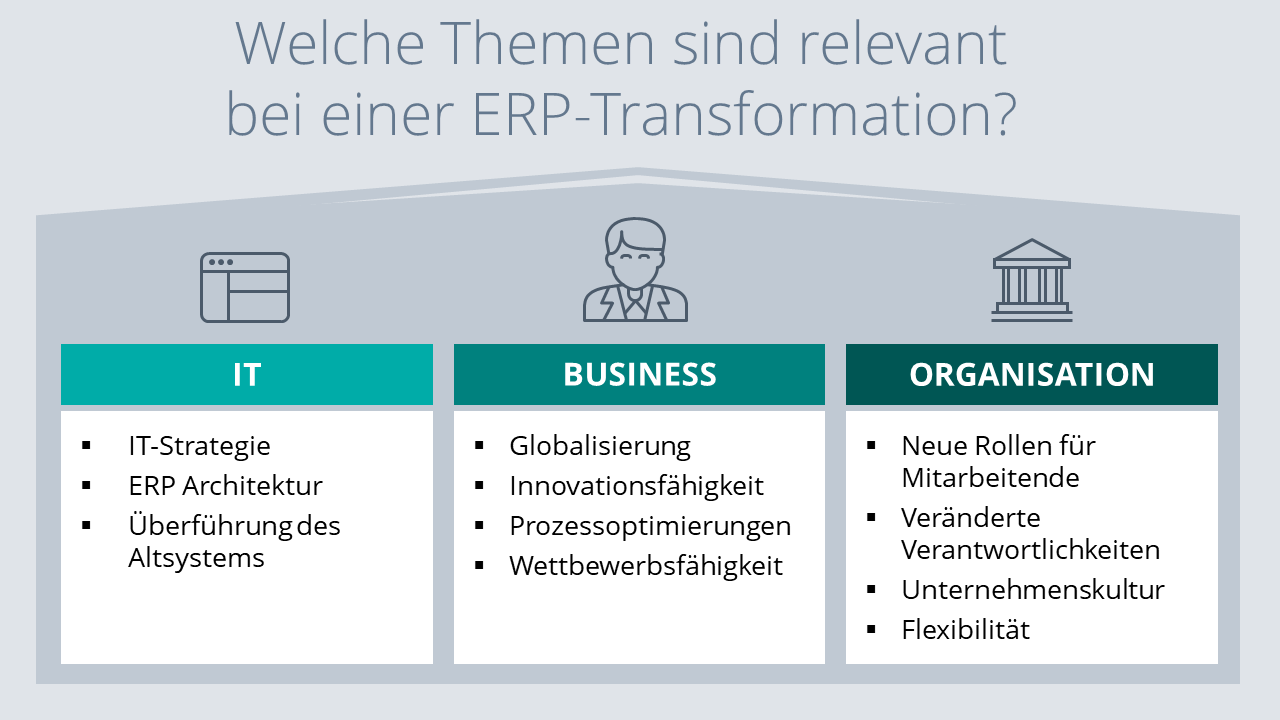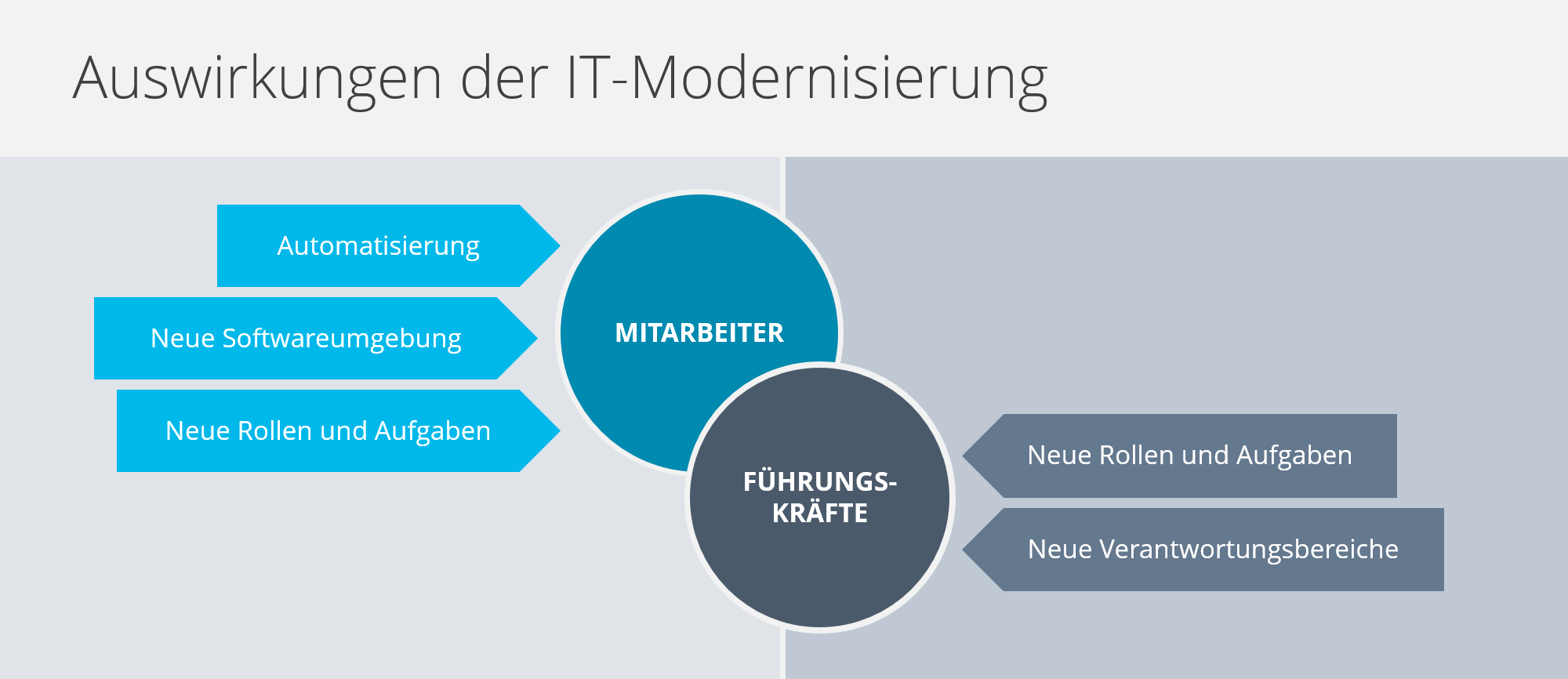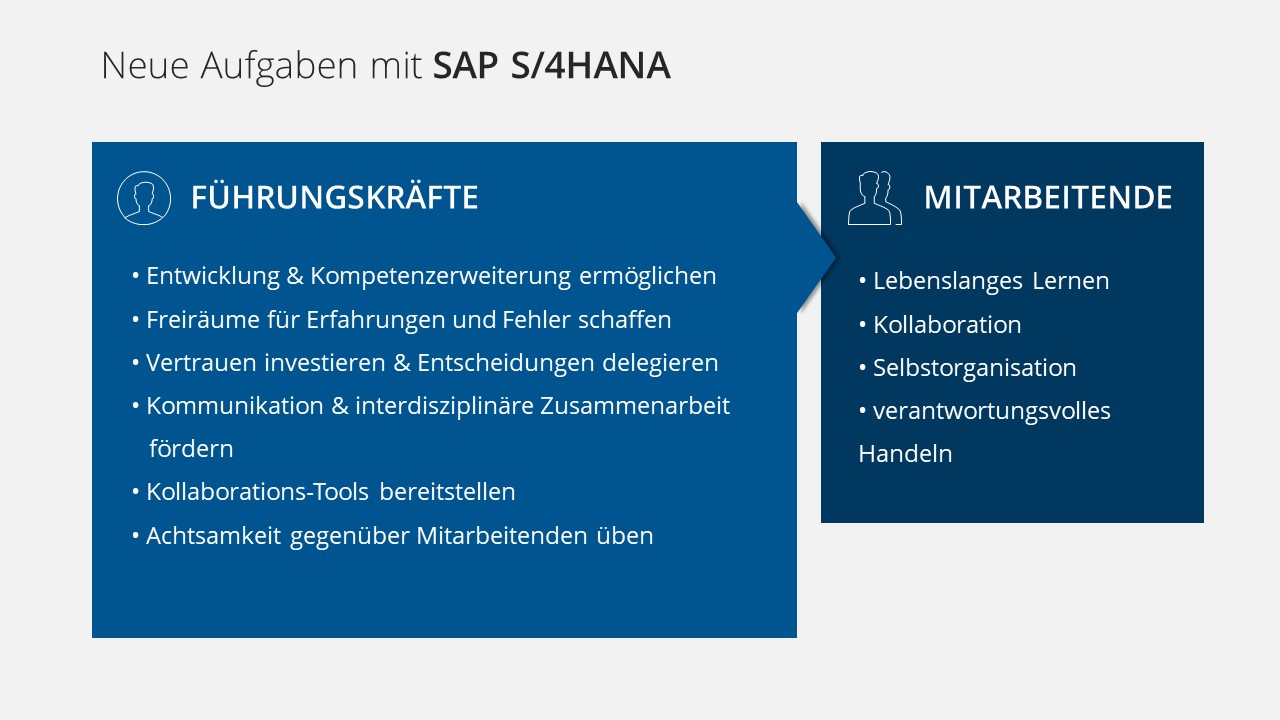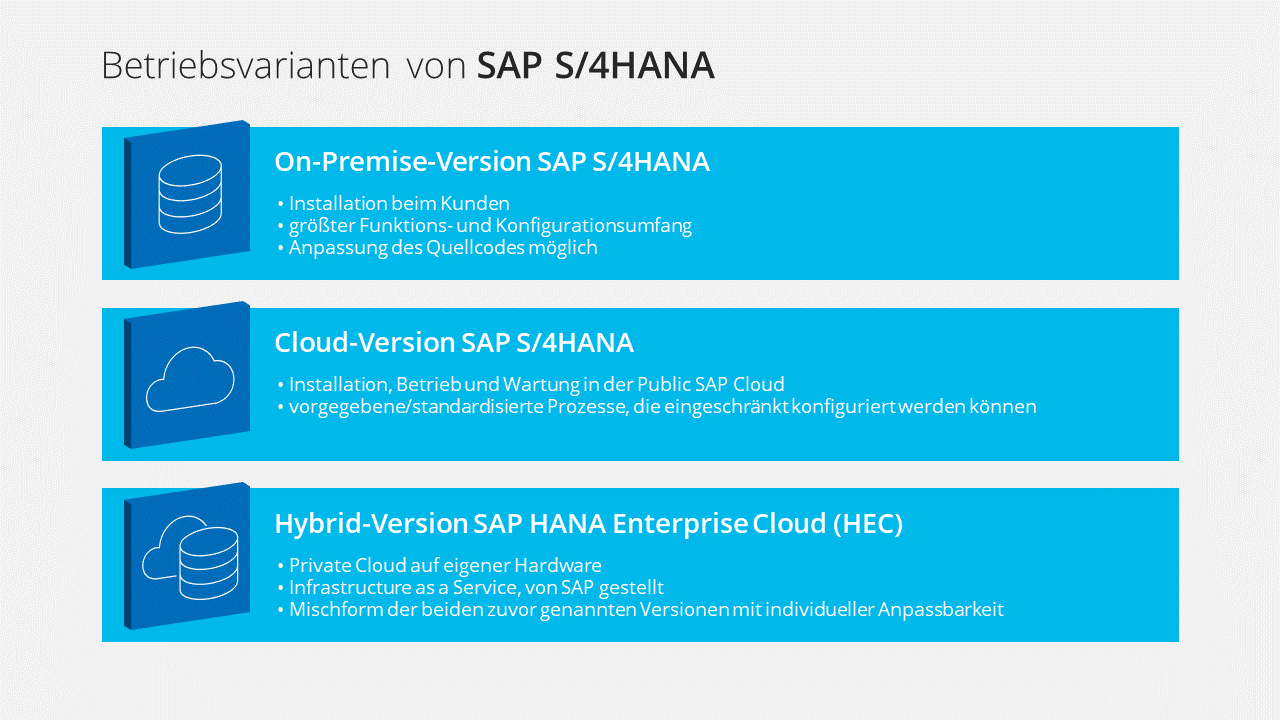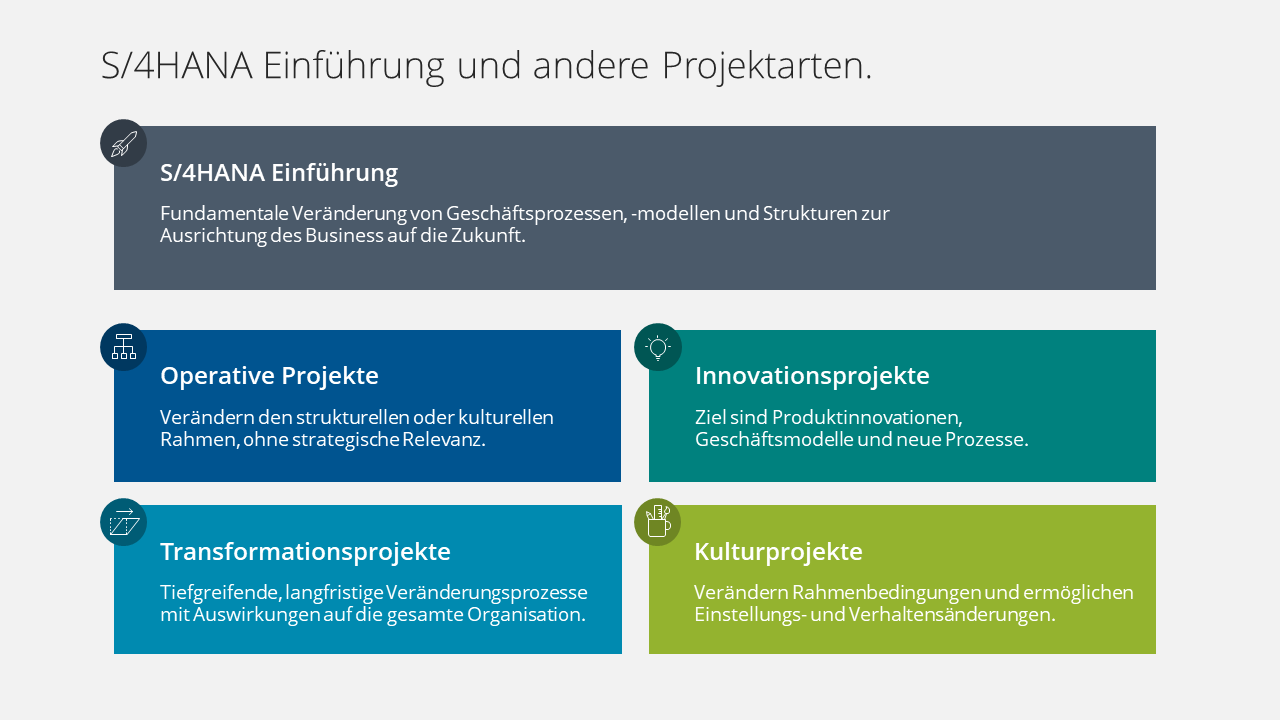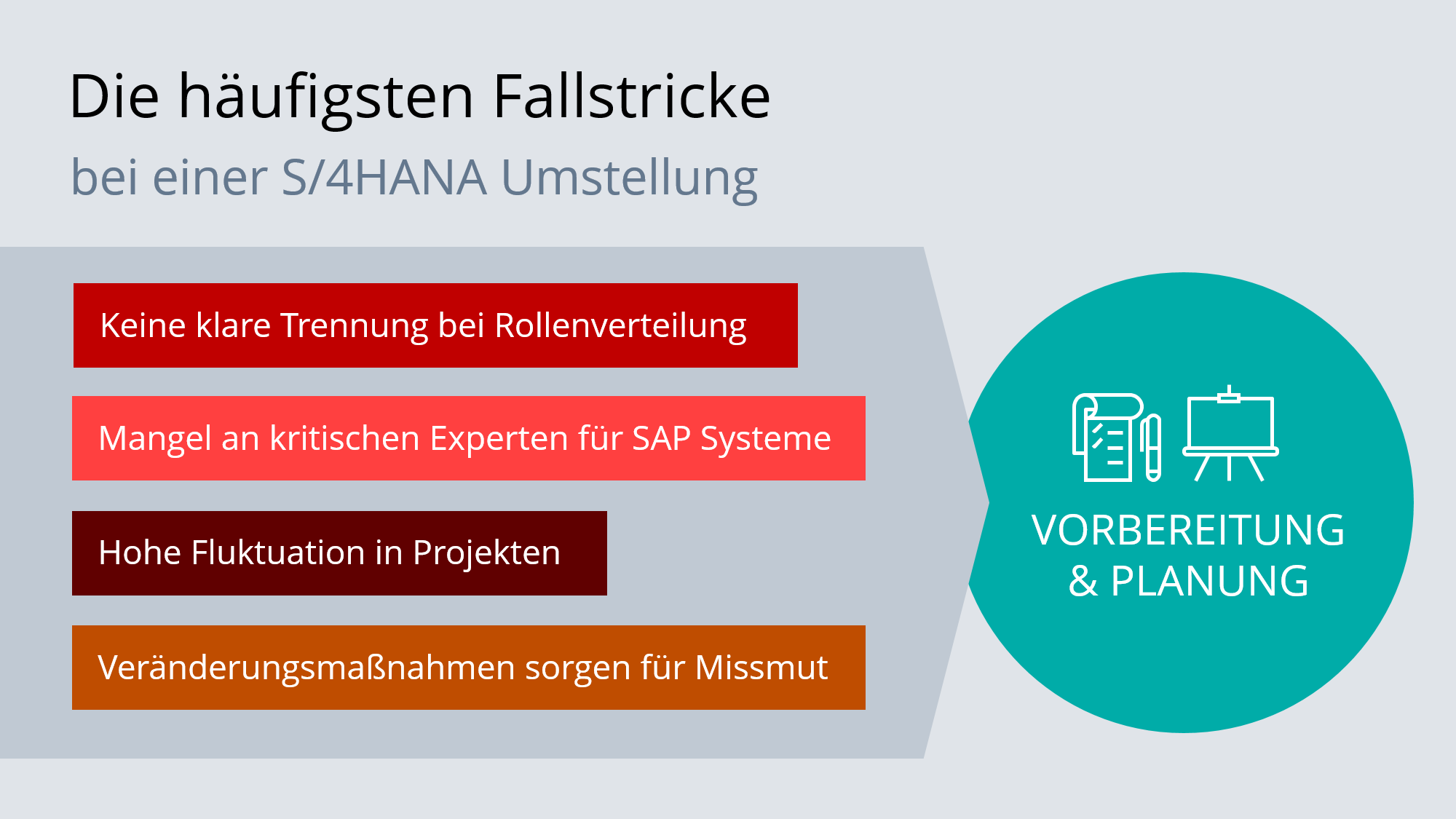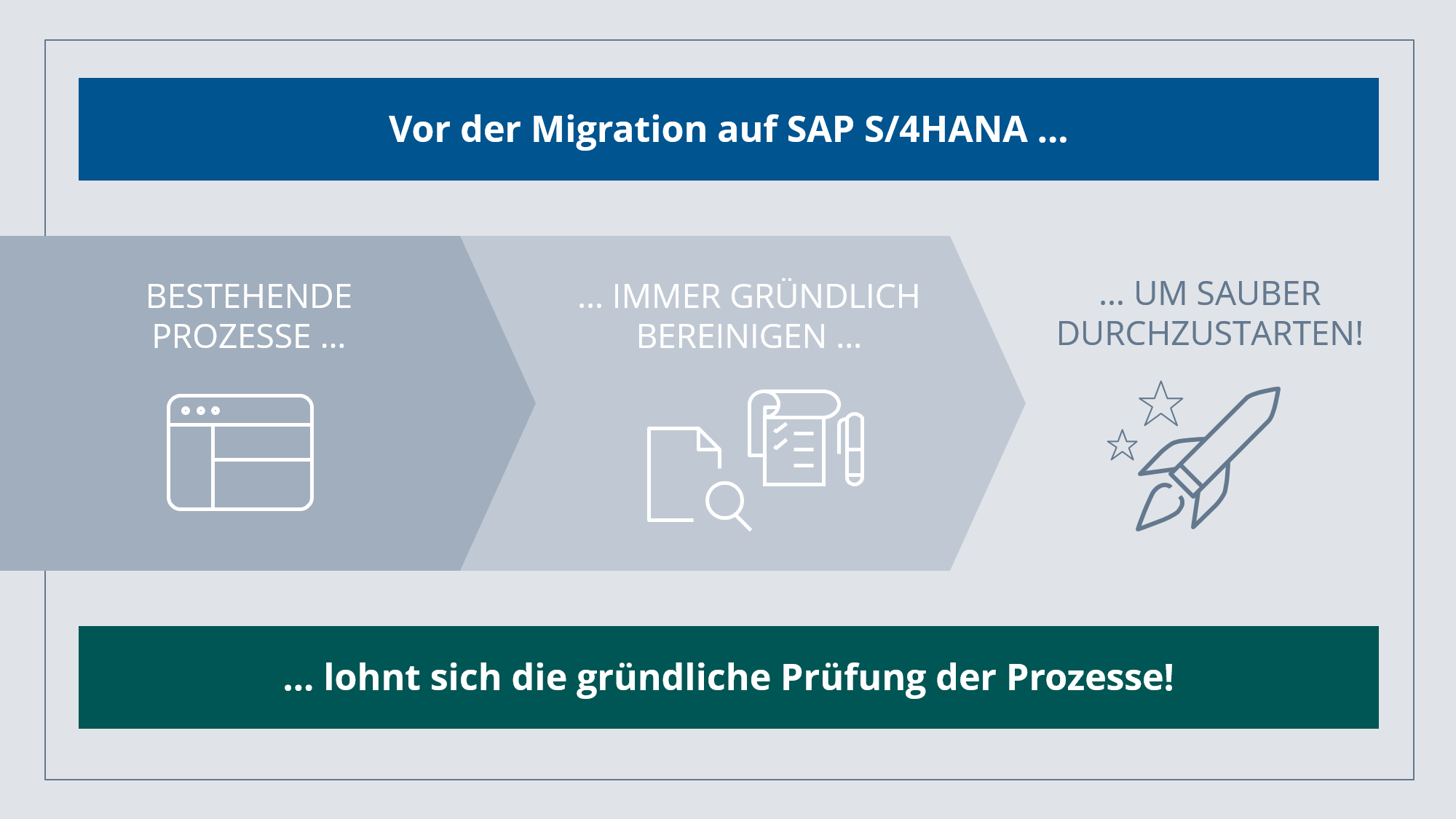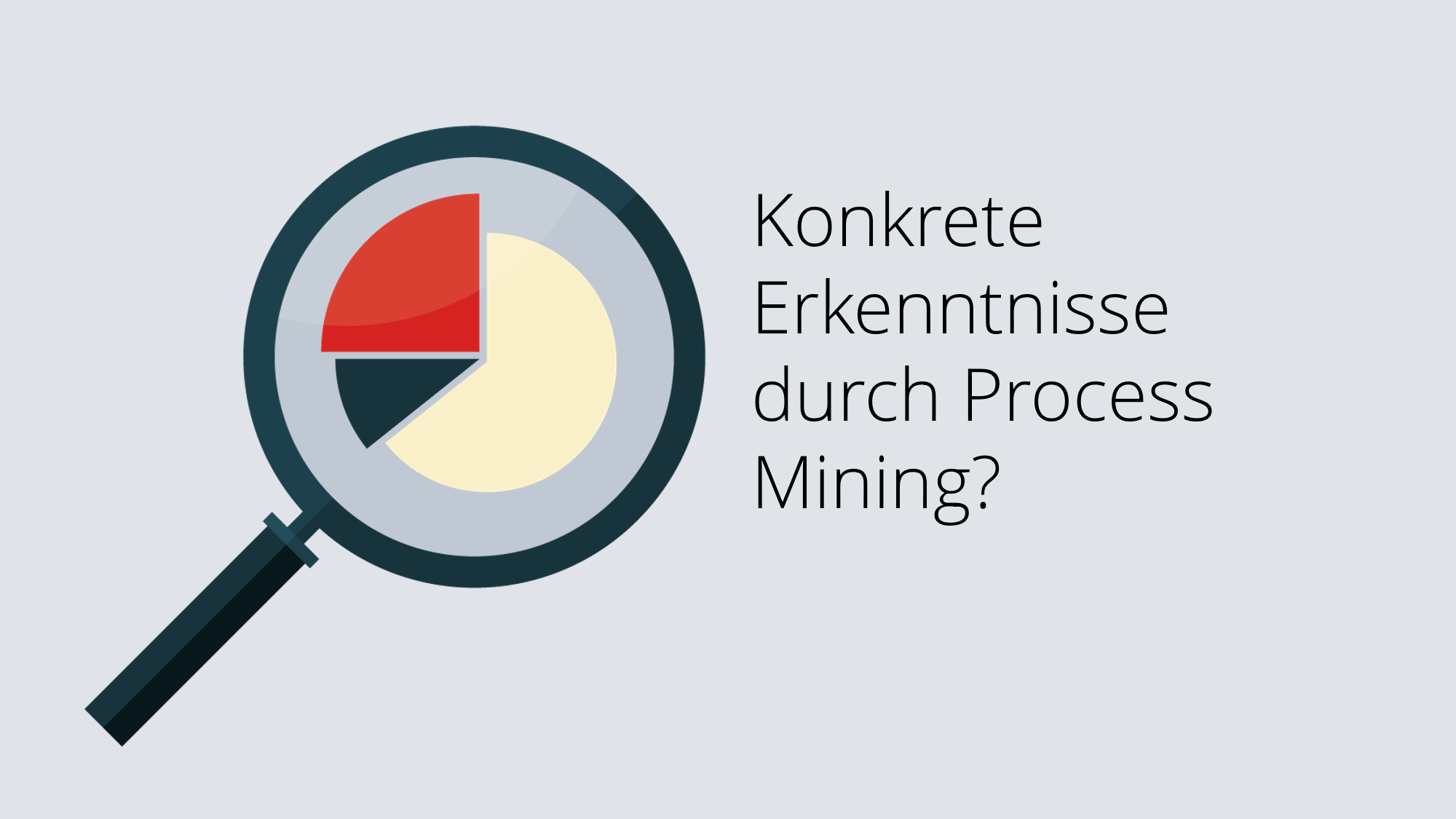The conversion to SAP S/4HANA goes hand in hand with a comprehensive transformation that affects all areas of the company. Those who see it as a purely IT project underestimate the changes that a conversion brings at all levels.
A holistic perspective is crucial for the success of the transformation. A digital transformation is only successful if all perspectives of the change are also orchestrated.
This concerns the digitalisation and IT strategy as well as process-related and organisational adjustments. At the same time, the continuous development of employees and managers is on the agenda.
Here we answer the most important, fundamental questions about the SAP S/4HANA transformation.
Do you have questions that are not answered here? Contact us by e-mail. We look forward to an exchange of ideas!
Erfolgreiche S/4HANA Transformation – die wichtigsten FAQ
- Who or what in the company is actually affected by an ERP transformation?
- SAP S/4HANA as a driver of productivity improvement in the automotive industry – dream or reality?
- What changes does SAP S/4HANA bring to the management of employees?
- SAP S/4HANA – when will R/3 support end and what is new?
- Not a walk in the park: What obstacles does one encounter in the course of an SAP transformation project and what can be done?
- Is an ERP transformation not just a project like any other?
- Successful project management for an SAP S/4HANA transformation – how does it work?
- Advantages and limitations of SAP Activate as a standard operating procedure
- What should an automotive company consider in the project management of an SAP S/4HANA conversion?
- SAP S/4HANA transformation – what are the typical challenges?
- Process management before an SAP S/4HANA migration – what problem does it solve?
- Classical process management vs. process mining: what are the insights?
- Process mining: how is it being used in the context of an SAP S/4HANA transformation in the automotive industry?
- Process mining can do a lot – what are the biggest benefits as part of an SAP S/4HANA transformation?
- What does SAP S/4HANA implementation mean for IT?
Who or what in the company is actually affected by an ERP transformation?
The introduction of SAP S/4HANA is often understood as a pure IT migration project. We, however, speak of an ERP transformation. Because it affects not only IT, but the entire organisation. But what does that mean? The question of “affectedness” alone can be understood in different ways:
- Who / which areas bear the main responsibility for the implementation of an ERP transformation? Who has the necessary competence?
- Where / in which areas can significant changes be expected? Who is significantly affected (change impact)? Which stakeholders need to be brought on board?
- What or which professional focal points of the changes are relevant? From which perspectives do I look at the transformation?
The first two questions about competence and change impact can only be answered meaningfully from a company-specific context, taking into account the implementation strategy (“greenfield”, “brownfield”). In order to get closer to a better understanding of “affectedness”, we look at the ERP transformation from different “glasses” or perspectives and ask about the relevance of professional focal points. In short: changes affect the focal points of business, IT and organisation, from a strategic and operational perspective. These perspectives are taken into account in the mgm ADDVALUE Transformation Framework.
Which topics are relevant in each perspective?
Business perspective: Strategically, business is concerned with globalisation, the acceleration of technological developments and, above all, with the customer, who must be won and fostered. With the increasing dynamics and complexity of the environment, an equally flexible business strategy with a high ability to adapt and innovate is increasingly essential. Those who use the possibilities offered by a modern IT landscape together with a standardised core such as SAP S/4HANA will increase their competitiveness. So questions arise about new business models or more efficient process standards with high automation potential in the context of technological possibilities. At the operational level, it is generally process optimisations, positive effects of restructuring or improvements in cross-divisional cooperation and higher degrees of self-organisation. All these aspects are relevant for the introduction of a modern ERP solution.
IT perspective: IT has the task of defining its strategy. As a target picture, the IT strategy provides orientation for daily decisions and sets priorities, supports resource allocation and budget planning. Depending on the business strategy and the business processes, IT is responsible for the architecture of the ERP system landscape within the framework of a business-IT alignment, defines the technical requirements and ensures the transfer of the legacy system to S4HANA and later the operational use of the system.
Organisational perspective: In the context of an SAP S/4HANA implementation, a number of organisational aspects need to be considered. In the course of new processes and tasks from Big Data and automation, employee roles are redefined, along with expanded responsibilities, required competencies and organisational structures. Continuous learning and experience will become increasingly important. Cultural framework conditions should be adapted accordingly. This requires a new understanding of leadership that, among other things, enables more flexible forms of communication and collaboration. Such contexts should be considered at the beginning of an ERP transformation as part of a change management concept.
SAP S/4HANA as a driver of productivity improvement in the automotive industry – dream or reality?
The automotive industry is facing major challenges in times of politically devalued diesel, climate change and the associated switch to electric mobility, changing consumer behaviour in the wake of new sharing models, and now also in times of the Covid 19 pandemic. Medium-sized suppliers are looking for continuous optimisation of the value chain and more effective quality controls throughout the entire product manufacturing and logistics process. They also need a more efficient exchange of data and information with business partners. With greater cost transparency, optimisation potential could be uncovered internally and detailed calculations offered to customers.
With the modernisation of the IT landscape in combination with an up-to-date ERP system, productivity can be significantly increased, if it were not for the human factor. Achieving the desired goals is not just an IT task, but also the task of professional change management that focuses on taking employees and managers along with them on the path of change:
- The adaptation of operational business processes means potential savings, but also has a change impact on the working environment of employees in structural and cultural terms.
- Manual repetitive processes are replaced by automation, which arouses fears among employees and can create a defensive attitude.
- With the introduction of new applications and user interfaces, roles, tasks and ways of working change significantly.
- With greater transparency of value chains, areas of responsibility are widening and creating pressure on managers.
If an adaptation under pressure to act only takes place on a technical level, and if effects on people, on their work processes and on the relationship structures in which they perform their work are neglected or not communicated, the risks of the market quickly shift to the organisation itself. If managers are involved too late, they cannot prepare their employees for the upcoming changes in time. A lack of orientation increases fears instead of hopes for economic prosperity. The success of an ERP transformation is thus shaken. Like a share price, confidence in the project disappears and the productivity of the workforce plummets. So think about change management from the very beginning – not just at go-live – and thus maintain and utilise the productivity of your employees.
What changes does SAP S/4HANA bring to the management of employees?
Companies are facing profound changes with the introduction of a new ERP system such as SAP S/4HANA. While silo structures and hierarchies have grown historically in many traditional companies, different demands are now being placed on the organisation and employees. Above all, a new understanding of leadership is needed.
The new possibilities of flexible and fast data evaluation based on SAP HANA that accompany SAP S/4HANA, the simplification of applications e.g. in accounting and logistics through SAP FIORI and a higher degree of automation of repetitive processes lead to a substantial change in work: while employees were previously still active in narrowly defined areas of responsibility, in future they will bear more responsibility with consideration of entire value chains up to the customer including the effects of their own actions (e.g. master data maintenance) on other business units. This means a greater readiness for transparency of data and information. Employees will develop into knowledge workers with analytical skills in dealing with an increasing amount of data. This requires a willingness to collaborate, self-organise and act responsibly, as well as a willingness to engage in lifelong learning.
This also means that managers have to rethink. They pave the way for their employees into a new S/4HANA working world. Their tasks are in particular:
- Enable development and expansion of competences,
- Create free spaces in which new experiences can be gained and mistakes can be made,
- To gradually invest more trust and delegate decisions at the working level,
- Promote communication and forms of interdisciplinary cooperation,
- Provide tools for collaboration,
- Practising mindfulness towards their staff.
They have to deal with the “digital natives” of Generation Y and Z as well as the “digital immigrants” of the older generation. There is no “best practice” recipe for this leadership task. It is about…
- exemplifying a culture of making mistakes and learning,
- respect for employees and colleagues regardless of hierarchies,
- a cooperative “eco-system” instead of being about one’s own ego,
- relinquishing control,
- high flexibility in the coordination of resources and
- agility across departmental boundaries.
These are not the clear advices that are usually requested, but guidelines that managers have to develop with foresight and tact.
SAP S/4HANA – when will R/3 support end and what is new?
A completely new product family
SAP is launching a completely new architecture with the S/4HANA enterprise software and is ensuring support for the existing R/3 product line until 2027. Extended maintenance options are offered until 2030 at extra cost. The central core is the modern database SAP HANA, which has a significantly higher performance due to its “in-memory concept”. The new architecture still contains some central functions of R/3, but the technological underpinning is completely different. This leads to an SAP migration project whose effort and complexity companies should not underestimate.
S/4 HANA consists of the following components:
- Finance
- Human Resources
- Sourcing & Procurement
- Supply Chain
- Manufacturing
- Sales
- Service
- Asset Management
- Research & Development
Since not all modules can be found 1:1 in the new HANA world, they can continue to be used until 2027 via compatibility packages. Companies must take these temporary transitional solutions into account when planning the migration.
Simplification and standardisation as a principle
In the past, SAP lived from the extensive customisability of its systems with regard to the data and processes of the respective customer – up to and including the customisation of the ERP source code. This led to increasingly complex and expensive SAP implementation and maintenance projects.
S/4HANA severely restricts this customisability at source code level and focuses primarily on simplification and standardisation: with its “Best Practices”, S/4HANA provides many pre-configured industry solutions and recommends adhering to these standards as far as possible. Individual customisations should be limited to the most necessary.
From the company’s point of view, this principle ensures significantly simpler processes and lower maintenance, testing and training costs. For the migration, however, it also means that all existing processes must be put to the test and adapted internally. The goal is end-to-end digitalised and automated business processes that make the organisation faster and more flexible. In addition, detailed analyses of huge amounts of data are possible in real time. This also improves the quality of forecasts and reporting – with less effort.
Individualisation by the business units
Whereas individual customisations were previously only possible with the help of SAP consultants and ABAP/Netweaver developers, S/4HANA relies on direct customisability and configuration by the business unit – even without IT specialists. These adaptations are usually limited to certain application areas in order to ensure the stability and compatibility of the overall system. Despite these restrictions, a large part of the processes can be adapted to the individual circumstances of the company.
The goal is to be able to react more quickly to internal and external (market) changes, to increase the speed of implementation and to significantly reduce the dependence on internal and external IT resources.
On-Premise-, Cloud or Hybrid
SAP S/4HANA is offered in different versions, which also differ in terms of functional scope and customisability:
- On-premise version SAP S/4HANA: Installation at the customer’s site, largest scope of functions and configuration, customisation of source code possible.
- Cloud version SAP S/4HANA: installation, operation and maintenance in the public SAP cloud, predefined/standardised processes that can only be configured to a very limited extent
- Hybrid version SAP HANA Enterprise Cloud (HEC): Private cloud on own hardware, Infrastructure as a Service, provided by SAP, hybrid of the two versions mentioned above with individual customisability
The requirements for operation and customisability of the processes determine the choice of version and a corresponding migration concept.
Conclusion: timely preparation on the IT and business side necessary
The departure from highly complex and costly SAP installations combined with simplified and standardised processes offers many advantages. Moreover, the 2027 deadline means that companies have almost no choice – except to switch to another ERP provider. In any case, it is important to prepare for a complex migration project in good time and to bring IT and business together.
Whichever variant the customer chooses, S/4HANA promises more cost-effective operation in the medium term and better adaptability to increasingly dynamic business processes – with fewer IT resources.
Not a walk in the park: What obstacles does one encounter in the course of an SAP transformation project and what can be done?
1. Economic barriers
Companies that want to take advantage of the opportunity to structurally optimise processes and organisation with the implementation of SAP S/4HANA must always expect additional costs, resource expenditures and temporary productivity losses, combined with long-term recapitalisation. This means: A company must also have the necessary capital or sufficient standing to finance a strategically effective transformation. This is not always the case, even if management has identified a need for action to optimise processes. The background may be the cost pressure, especially for smaller players, that can arise from a change process with the S/4HANA introduction. The short-term success achieved with a quick technical implementation often enjoys priority here.
Another reason for the delayed introduction could be the lack of agreement on the strategic directions within the management.
2. Cultural barriers
S/4HANA is more than a technical implementation. The introduction means a significant change in the entire organisation, the business processes and the ways of working. The requirements of the business are in the foreground, combined with new possibilities for automation and an enormous potential for innovation and optimisation. Such a change requires the opening of silos along value chains, the flexible use of modern applications, the analytical handling of numbers, data and information. And it requires decision-making with greater leeway, combined with the willingness to learn continuously.
The step from uniform task fulfilment with a high proportion of recurring processes to working with SAP S/4HANA, which gives the business more freedom, is comparable to a step into a new cultural landscape. Culture is a stabilising element. But at the same time it can be an inhibiting element when it comes to changes to the system. Companies often find it difficult when it comes to cultural change. In this way, culture acts like a rubber band and always pulls the organisation back to its original state. Energy is needed to sustainably manifest new habits and management practices in the operational business.
3. Individual obstacles
In addition to economic and cultural framework conditions, it can also be the attitudes and experiences of decision-makers that can act as obstructive force fields. For example, it is sometimes experiences with failed change processes that cannot be reconciled with the idea of a comprehensive transformation, even if economic arguments speak in favour of a transformation.
Such “cognitive dissonance” may lead to distortions in perception, especially to the devaluation of the actual opportunities of such a significant transformation as SAP S/4HANA as well as to the valorisation of its risks. Another thesis is based on the change fatigue in the workforce as well as in management that may have set in after the many mergers and spin-offs in the industry.
An SAP S/4HANA implementation is a complex process, associated with many imponderables before it starts and with the need for organisational and individual learning throughout the implementation process. It is recommended to start the learning process, especially for managers, even before the start of such a project, to gain insights and acquire knowledge. For this purpose, mgm has developed the concept “S/4HANA Learning Journey”, which includes all phases and challenges of a transformation. This enables decision-makers to overcome individual obstacles and doubts and to gain confidence in the face of such a far-reaching strategic decision that sets the course for the next decade.
Mitigating the barriers
To mitigate the economic, cultural and individual barriers, we recommend the following activities:
- Clarify at an early stage the opportunities that arise for your business from the new technical possibilities of a S/4HANA implementation and weigh them against the possible risks in your organisation.
- Adjust your corporate and digitalisation strategy accordingly and take this as a target for your implementation decisions.
- Consider possible conflict potentials between affected areas in your change planning.
Start team-building processes of responsible decision-makers on the IT and business side at an early stage. - Check your organisation’s willingness and ability to change at an early stage by analysing inhibiting and supporting cultural force fields.
- As a decision-making aid, start a comprehensive learning process (“S/4 learning journey”) at an early stage to gain insights and knowledge so that you can better deal with expected blockages.
Is an ERP transformation not just a project like any other?
In order to understand the versatility of a transformation, especially in connection with an ERP or SAP S/4HANA implementation, it helps to distinguish it from other types of projects.
Delimited operational projects concern the business or IT. These include process optimisations, marketing campaigns, improvements in the cooperation between two departments or the relaunch of existing software. Such projects change the structural or cultural framework only selectively and usually have no strategic relevance.
Innovation projects concern new business models, products or processes and aim to renew organisational or technical structures within the framework of an existing strategic orientation. These include technical innovation projects for the provision of new IT applications or functionalities as the basis of process innovations. Or they are product innovations with partly disruptive market development effects. Characteristics of such projects include multidisciplinary cooperation and the development of corresponding competencies.
Cultural projects pursue the intention of generating sustainable changes in attitudes and behaviour. In the context of structural or strategic realignments, the focus is on acceptance of the changes in parts or the whole organisation. One example we are experiencing these days is where communication is redefined in the context of “social distancing” in companies and tools provided are also understood and used as effective means for ‘remote collaboration’. Characteristics of this type of project are changes to the framework conditions that enable new behaviours, as well as the establishment of regular or permanent feedback opportunities.
Transformation projects involve profound and long-term change processes with noticeable effects at all levels of the entire organisation. Transformations are characterised by a high degree of complexity, which manifests itself in mutually influencing strategic, structural, cultural, human and technological factors and thus limited plannability. Transformations have an impact on corporate and digitalisation strategies, as well as on management practices, working methods and organisational structures, including the roles and tasks of individual employees. Thus, transformations encompass all elements of other types of projects. Characteristics of transformations are an upheaval from the old to the new, the redefinition of business models or the realignment of the company as well as internationalisation or centralisation.
The introduction of S/4HANA is also a transformation if S/4HANA is understood not only as a pure IT solution, but as an opportunity and process to align the business with the future. This involves fundamental changes to business processes, organisational structures and business models. As a result, a S/4HANA transformation also brings about a cultural change, as employees are relieved of routine activities, for example, and develop into knowledge workers with greater scope for decision-making. Interactions arise above all between the development of the new IT landscape and the requirements of the business. Only those who take all these factors into account over a longer period of time can use the full potential of an SAP S/4HANA solution.
Successful project management for an SAP S/4HANA transformation – how does it work?
An SAP implementation or the conversion and migration to S/4HANA can resemble a mammoth project. The usual pitfalls of a large project lurk: deadlines are not met, budgets are exceeded, important stakeholders are not included, employees are not picked up. However, if an SAP project is managed correctly, great opportunities arise that lead to the long-term optimisation of structures and processes in the company.
These are the most important success factors in the project management of an SAP S/4HANA project:
- Methodological competence of project management: The project manager is often mistakenly seen as the technical support, but proven project management skills and methodological know-how are equally indispensable for the success of a project.
- Clear distribution of roles: An SAP implementation affects all pillars in the company (IT, business and organisation). A functioning IT-business alignment is a prerequisite for clearly defining competences. With key users or business process experts, the business department is just as involved and jointly responsible for the success of the project as system architects or the development team from the IT department. Clear and transparent responsibilities and project roles create commitment and help to keep to deadlines and budgets.
- Management commitment: A prerequisite for a successful project is that the scope of the conversion or introduction of S/4HANA is known to the management and that the undertaking is supported equally by all. It needs the full backing of management to ensure the necessary support for organisational changes and decisions at all levels concerned.
- Agile project management: A certain degree of flexibility and agility helps during all phases of the project. Only in this way can new findings be taken into account quickly and without great effort in the course of the project. It is not about strictly adhering to a plan defined at the beginning, but about achieving the desired result while being able to react to changes. A procedure according to SAP Activate offers a good basis as a standard procedure, but only the use of suitable agile methods (design thinking workshops, customer journeys, service blueprints, Scrum, etc.) ensure the success of the project.
- Comprehensive project communication: Not only within the project team, but throughout the company, employees must be brought on board and carefully prepared in dialogue for the far-reaching changes brought about by the S/4HANA migration, which usually affect almost all areas of work. Success stands and falls with the support and acceptance of the users who use SAP in their daily work. End users should be included in the definition of requirements as early as the concept phase in order to ensure broad support.
- Change management: SAP S/4HANA affects all areas of the company – such a transformation changes the DNA of the company. Preparing the organisation for the far-reaching changes is critical to success and should be considered in all essential steps. Tailor-made change management creates identification with the change measures and supports the success of the project.
- Coaching of team members: Due to the high scope and long duration of the project, a certain fluctuation of staff should be taken into account. Accompanying coaching and – whenever necessary – rapid methodical induction of new project participants should therefore be ensured throughout the entire duration of the project in order to guarantee smooth cooperation and not jeopardise the ability to deliver.
- rely on SAP Best Practices: The provision of industry best practices, i.e. standard processes, is an essential element of SAP S/4HANA and one of the central innovations. With S/4HANA, SAP deliberately relies on industry-specific standard processes instead of complex customising. This possibility of being close to the standard should definitely be used to make the system and also the implementation as efficient as possible.
Advantages and limitations of SAP Activate as a standard operating procedure
With the introduction of the new SAP S/4HANA product family, SAP has also launched a new process model for the introduction of software under the name SAP Activate. The model is available for cloud and on-premise operating models and can be used for new installations, conversions, updates or the transformation of entire IT landscapes.
What is SAP Activate?
SAP Activate was developed to support the implementation of new products – currently mainly SAP S/4HANA – and the related project management in an efficient way. During the initial implementation of HANA, the SAP Activate framework is intended to shorten the project duration. During ongoing operation, it helps to keep the maintenance effort for the system low. Overall, SAP Activate aims to reduce the operating costs and payback times for S/4HANA.
The three main components of SAP Activate are:
– Business Process Best Practices.
– Guided Configuration, the provision of standardised configuration tools
– the methodology for implementing the system
However, from a project management perspective, it must also be asked whether SAP Activate contributes significantly to the realisation of IT projects or also supports the structural and process-related change in the company triggered by the implementation.
Best Practices
The central component and an elementary innovation in the course of the introduction of SAP S/4HANA are the Best Practices. These are predefined standards and business processes. They are available as so-called “Industry Solutions” for different industries. The energy sector is included here. As reference solutions, the Best Practices are adapted to the production and the market of the respective industry. They serve as a benchmark for companies to orientate themselves on, especially if they want to use the advantages of standardisation.
Guided Configuration
With Guided Configuration, SAP Activate provides a comprehensive arsenal of tools for implementing the system. Guided Configuration is based on industry-specific best practices. As a rule, it is carried out by a process owner/key user from the company together with an SAP consultant. Individual system adjustments are possible to a certain extent within this framework. Data migration from older systems and automated test runs for the cloud operating model are also carried out as part of the Guided Configuration.
Implementation methodology
For an efficient implementation of S/4HANA, so-called accelerators have been integrated into SAP Activate, which are also based on best practices. The methodology can be used regardless of the operating model (cloud or on-premise) and the method of system implementation (new installation, conversion, etc.). At the same time, it is scalable for different company sizes. As with best practices and guided configuration, the implementation methodology also focuses on the technical aspect.
The implementation process and thus the project management for the introduction of S/4HANA is divided into a total of six phases in SAP Activate:
- Discover – Gathering information about the system and its deployment options, selecting the product version.
- Prepare – setting up the product, installing the system landscape
- Explore – process analysis, comparison with S/4HANA standards, development of training plans
- Realise – configuring the system based on the requirements defined in the Explore phase, connecting with other products, testing, conducting training, feedback from business departments
- Deploy – final preparations for company-wide rollout
- Run – introduction of the system, collection of user experiences in order to prepare for possible expansion decisionsSummary: The focus of the SAP Activate process model is on system implementation. The necessary consideration of a structured change management and communication approach is not covered in this framework. In the course of the SAP S/4HANA implementation, however, companies can fall back on other procedures for this that are based on the Activate phases – for example, on the ADDVALUE change framework that mgm has developed specifically for HANA implementations.
What should an automotive company consider in the project management of an SAP S/4HANA conversion?
The SAP Activate approach offers a standardised approach – but every company in the automotive industry is individual. In the automotive sector in particular, both manufacturers and automotive suppliers have complex sales chains, processes and production chains that often push a standard implementation approach to its limits. The particularities of an organisation with its special structures and requirements can hardly be mapped in a generally applicable procedure; this requires methods and approaches that go beyond this. It is advisable to look beyond the SAP Activate method in the following areas:
Requirements definition: SAP Activate works with best practices, but only parts of these can do justice to the complexity of an automotive company. It is important to find company-specific solutions and to experiment with other approaches in order to find the “best match”. The initial phase of the project is ideal for this, as there is still a certain degree of flexibility. When it comes to defining the architecture, for example, design thinking workshops are a suitable approach to capture the complexity. Customer journeys or service blueprints offer suitable support for understanding the ACTUAL processes in the company and then setting up the TARGET processes with a comprehensive understanding of the processes.
Implementation: Like other IT projects, an SAP S/4HANA project can also be implemented in an agile manner. The concept of iterative sprints and flexible backlogs primarily describes software developments, but complemented with agile approaches to requirements gathering and maintenance as well as test procedures, the benefits of Scrum in the SAP project are significant. The product owner can be better integrated and the visibility of the project progress and thus the increased reaction speed in case of adjustments are significantly increased. Coupled with requirements, change and test management, Scrum is an ideal method for structuring the complexity of an SAP S/4HANA project.
Coaching: Regardless of whether you use SAP Activate and Focused Build for SAP S/4HANA in project management or alternative methods such as Design Thinking, Customer Journeys or Scrum – there is always a high coaching effort in this type of project. An important aspect for successful project management are the roles within the project, for example the key user from the business department or the business process expert who is the first contact person for individual processes. As a rule, the bearers of these roles are not the ones who need project management skills and methodological knowledge in their everyday work, so they must be prepared and coached for an SAP project in a dedicated way. Within IT, a common method and solution must often first be developed to deal with the business requirements. This is where coaching is needed. Due to the complexity and long duration of an SAP migration, there is a certain fluctuation in the team. Onboarding of new team members, consisting of both external consultants and internal employees, must be ensured throughout. A technical project manager is usually overloaded and overstrained with this coaching requirement in addition to the actual task. It is therefore advisable to outsource coaching tasks and integrate them during the initial project phases.
SAP S/4HANA transformation – what are the typical challenges?
Good project management is the basis of a successful S/4HANA conversion. Those who do not master their craft risk a successful migration to a new ERP system. You should therefore deal intensively with the special features and challenges of an SAP project before the project begins in order to avoid pitfalls:
- Role allocation: Ensure a clear allocation of roles (support tasks in day-to-day business vs. project tasks in the context of the S/4HANA conversion). The separation between project tasks and line tasks should always be ensured and carried out by two different roles.
- Resource availability: Create a realistic, transparent resource plan before the start of the project in order to avoid personnel bottlenecks. Without this, you run the risk that the critical business people and experts needed for SAP systems will not be available in the company for the entire duration of the project.
- Fluctuation in the team: In an ERP project with very long project durations and a high scope, there is naturally a fluctuation of employees within the team. Methodical coaching and familiarisation with the implementation approach “Focused Build” for SAP Solution Manager (approach, roles and tools) must therefore take place throughout for new team members in order to ensure fluent project onboarding and consistent productivity in the team.
- Employee communication: Change measures due to the SAP S/4HANA conversion can cause resentment among employees if they are not involved. Remember that this is a transformation of the company that affects all employees. Proactive change management and good communication make employees supporters of the project and can counteract employee blockades.
Process management before an SAP S/4HANA migration – what problem does it solve?
Good process management determines the economic future of the company. The conversion from SAP R/3 or another ERP system to SAP S/4HANA is a transformation that affects all of the company’s core processes and thus offers a great opportunity to question processes and reorganise them for the future. In the process, the company can, if necessary, free itself from legacy and process uncontrolled growth and thus map processes optimised and closer to the simple SAP standard. This is because IT systems in companies have often grown organically. If a new process was subsequently mapped in the system, customising and special solutions were often resorted to. In this way, the system moved further and further away from the standard and became confusing and expensive to operate.
The conversion to S/4HANA is comparable to moving into a new house. Ballast and unneeded items should be disposed of before a lot of effort is put into packing all the boxes and carrying them into the new home. It is a well-known fact that once everything is in place and you have become accustomed to the view, it is all the more difficult to clear it out later. But it is also important to ask: What can be better in the new house thanks to completely new planning? How do you arrange the rooms when you start building from scratch instead of renovating an old house? To answer this question, it is good to take a look at the generally accepted standard: How would one build a house today? Or in this case: Can the SAP standard be used for my company? It is particularly important to take into account the experience gained: What have I learned from the past? What do I really need? What special feature distinguishes me from others? What generates business value? Or here: How do my processes actually work? What is superfluous and what is indispensable?
This is exactly where process mining comes in. All processes mapped in the ERP leave valuable traces in the databases. These can be processed and evaluated with process mining. This makes it possible to see how and in which variants the processes in the system actually run. On the basis of this data, it is quickly recognisable where optimisation possibilities exist through which costs can be saved. The findings can then be incorporated into the templates of the new ERP system. Processes can be streamlined and best practices and standard processes can be used.
Especially for large companies that are affected by a merger or the amalgamation of entities, the efficiency of processes that run differently can be checked in this way. In addition, a comparison of the company’s divisions makes it possible to determine the company’s own best practices in order to continue to work together profitably in the future.
If the transformation brought about by the switch to SAP S/4HANA – i.e. the deep intervention in the DNA of a company – is accompanied by a simultaneous review and renewal of processes, companies are laying the strategic foundation for the digitalisation of the coming years. After all, who wants to move into a house with old burdens from days gone by that does not meet the needs of the occupant and is also far too expensive? The conversion from S/4HANA is the opportunity to redesign the house according to the needs of the occupants.
Classical process management vs. process mining: what are the insights?
Above and beyond classic process management, process mining creates data- and fact-based transparency about the processes and process flows in the company.
While workshop rounds of classic process management often only create an abstract or idealised image of the process, the real process can be represented exactly and with all its variants in a process mining software. Thus, not only the question can be answered here: What is the basic pattern of a process? But also: Which process variants occur when? How are the processes interrelated? And where does the actual process deviate from the target? And above all: why? Companies can hardly answer these questions without a structured look at the data. As a result, many optimisation potentials, such as cost reductions or shorter throughput times, are difficult to achieve due to a lack of transparency.
Process mining brings light into the darkness here. As a component of business process management (BPM), the technology can evaluate and analyse the data of all business processes that run via IT systems. Every process in a company that leaves traces in databases such as ERP systems, CRM or other applications generates valuable information that can be structured and analysed using process mining. This shows how individual processes run and how the process steps are interrelated. Individual process steps can be zoomed into in order to view them separately. Throughput times can be determined and correlated, e.g. in a comparison of variants. Compliance-relevant deviations in the actual process are also recognised. It is particularly important to analyse the causes of anomalies and pain points. If, for example, the throughput time in a plant is particularly high, AI processes can be used to find out whether this is due, for example, to particularly complicated orders, delivery bottlenecks of material to a location or problems in the organisation of the processes.
Process mining thus creates transparency and thus the basis for optimisations and targeted changes in the company.
Particularly in the run-up to an SAP S/4HANA transformation, process mining offers the possibility to scrutinise existing processes in order to subsequently map them optimally in SAP S/4HANA. During the migration, errors can be proactively detected and thus risks minimised. But even after the migration to SAP S/4HANA, ongoing process mining, including dynamic analyses based on real-time data, provides valuable information for the continuous improvement of business processes.
Process mining can be easily applied to all SAP modules and transactions, for example to the analysis of the purchasing process via order-to-cash to the comparison of different variants of the material master data process. Process mining provides valuable insights in all business areas beyond the results of classic process management.
Process mining: how is it being used in the context of an SAP S/4HANA transformation in the automotive industry?
ERP implementation projects in automotive companies are usually large-scale, cross-location transformation projects and therefore also require significant process transformation in order to be able to use the ERP systems successfully. Automotive manufacturers and suppliers are characterised by complex production and manufacturing processes that must be able to be mapped in an ERP system. With S/4HANA, which will replace the current R/3 in 2027, SAP is taking a significant step towards standardisation. This is important and right, as it increases the consistency and transparency of processes and thus the traceability of quantity and value flows and brings efficiency to logistical processes. For OEMs and car manufacturers, however, this step also means that they have to take a close look at their existing processes.
Process Mining offers an automated process analysis that analyses the company processes based on the data traces in the previously used ERP systems. Process mining provides a digital and fact-based, complete analysis of the core processes that can support the implementation or migration project at every step through transparent data evaluations, i.e. before the start of the project to determine the ACTUAL processes, during the project to define the TARGET processes and the requirements and afterwards through targeted monitoring and success control.
For example, process mining can be used to analyse the company’s “Procure to Pay”, “Order to Cash” or “Forecast to Fullfill” processes to determine whether the future TARGET process in S/4HANA should be standardised according to SAP standards or customised in a company-specific template based on specifications from the old ERP system. In addition, process mining can also be used to select suitable standard process instructions from the SAP Best Practices Explorer and to analyse the necessary process changes prior to the introduction of the new ERP system and the process implementations.
Process mining can do a lot – what are the biggest benefits as part of an SAP S/4HANA transformation?
Process Mining ist eine Technologie für die automatisierte Prozessanalyse, die basierend auf den Datenspuren in IT-Systemen die Unternehmensprozesse visualisiert und analysiert. Mit
Process mining is a technology for automated process analysis that visualises and analyses company processes based on the data traces in IT systems. With process mining, you practically get a digital and fact-based complete analysis of the core processes and can use this for process optimisation. This is particularly exciting in the case of mass processes, as they are classically mapped in ERP systems such as SAP, because if there are even small deviations or errors there, then these multiply and cause, for example, high unnecessary additional expenditure in total. The integration of process mining software is particularly easy with SAP systems, but in principle this is possible with all ERP systems.
The use of process mining in SAP R/3 or S/4HANA makes it possible to make the processes in the company visible and understand them. With the process mining technology, raw data from the ERP system in the form of SAP transaction data or change documents, for example, is prepared and analysed in a graphically understandable way. Through the visualisations and data analyses, weak points or deviations in the compliance of the examined processes can be identified very quickly. For individual processes, it can be determined exactly how long tasks take, whether they were fulfilled as desired and at which points manual intervention was necessary and with what effort. Thus, the analysis with process mining is also a good basis for the automation of processes or a possibility of preliminary work in order to automate processes in the future. Companies can thus identify weaknesses and optimise their processes.
For SAP in particular, many companies are currently facing a transformation to SAP S/4HANA. For such a transformation, process mining is the perfect add-on in all phases – before, during and after the migration. Because with process mining you practically get a digital and fact-based, complete analysis of the company’s core processes. The possibilities range from an analysis of the existing processes as a basis for optimised mapping in S/4HANA, to monitoring whether adaptation can achieve the desired effect, to a real-time view that enables timely intervention.
In this way, process mining brings transparency to processes that previously could only be analysed with a great deal of effort and days of research, if at all.
What does SAP S/4HANA implementation mean for IT?
Whereas for companies in the past decades it was the efficiency of processes and organisation, in the digital world the focus is on customer centricity, innovative power and data analytics. This “strategic shift” is now also taking place in the area of IT and in software and hardware solutions.
Whereas in some organisations IT is regarded as a pure service provider from the point of view of the business, in the course of digitalisation one speaks of business-IT alignment and means the mutual and continuous coordination between the organisational units of business and IT with regard to strategy, processes and projects, and also expresses the quality of “modern” communication on an equal footing. This alignment is particularly crucial for success in the introduction of S/4HANA against the backdrop of a highly complex transformation with strong interactions between the business strategy and the technical possibilities of a modern ERP system landscape.
Business-IT alignment as a success factor for the SAP S/4HANA transformation.
With the modernisation of software and hardware solutions, SAP in particular is making the leap into the digitalisation of the 21st century with S/4HANA. With the in-memory database SAP HANA, data can be made available in greater variety at high speeds. Applications are simplified and made more flexible for the user (SAP FIORI). With machine learning (SAP Leonardo) and higher levels of automation, employees are developing into data analysts. In addition to the new quality of collaboration with the business, SAP S/4HANA means a loss of control over outdated IT systems for IT with the conversion to the cloud edition (greenfield approach). Even with an “on-premise” solution, skills in designing interfaces to S/4HANA are more expected. In addition to learning completely new applications, this also requires the willingness to adapt one’s own competences and roles. Accordingly, the S/4HANA transformation is also taking place in IT.
The S/4HANA transformation is also being completed in IT.


